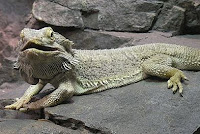One of the most popular new animals in the exotic pet world
is the steppe runner. They haven’t been in the States very long, so collectors
are anxious to own them and to learn more about how to take care of them. This
is just a short video, but it will give you a good idea of how to furnish and
light the housing for this reptile. Additionally, you can get a good look at
this little fellow near the end of the video.
As you can see, clean sand makes a good substrate. There are
two reptile caves in the tank, too. Lizards can go in these to hide or rest at
night. There is a cactus to make the reptile feel at home, and there is a pool
for drinking water and soaking.
The 100 watt basking lamp is housed in a large dome and is
situated right over one of the basking rocks. The rocks are important because
the lizard likes to lounge on them. She mentions that there are three levels of
heat running from around 100 degrees on one end down to about 80 on the other. This
is a perfect setup for the steppe lizard as it will move around to adjust its
body temperature.
This is a very nice and attractive setup. It is not
expensive to put a setup like this together, and it really adds to the pleasure
of viewing the animal. The backdrop adds a lot, too, and those are inexpensive
as well.
As you can see, this is a simple setup that shows how easy
it is to care for a steppe lizard. A rig like this would work well for other lizards,
too, and also for small snakes.
Hope you enjoyed the video.

